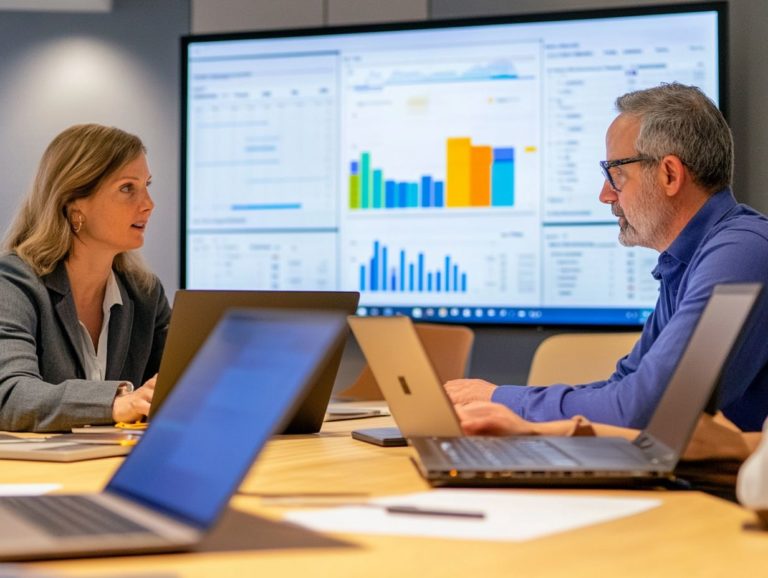the benefits of continuous vulnerability assessment
In today s fast-paced digital landscape, understanding vulnerability assessments is essential for keeping your data safe. This article discusses what these assessments are and their primary purpose. It underscores the advantages of adopting a continuous approach.
The benefits are hard to ignore. Continuous assessments bolster security, refine risk management, drive cost savings, and enhance operational efficiency.
You ll find an outline of critical steps for successful implementation, a discussion of common challenges, and an emphasis on the necessity of conducting regular assessments.
Get ready to explore how continuous vulnerability assessments can significantly strengthen your organization s defenses.
Contents
- Key Takeaways:
- Understanding Vulnerability Assessments
- Benefits of Continuous Vulnerability Assessment
- Implementing Continuous Vulnerability Assessment
- Challenges and Limitations
- Frequently Asked Questions
- What is continuous vulnerability assessment and why is it important?
- How does continuous vulnerability assessment differ from traditional assessments?
- What are the benefits of continuous vulnerability assessment?
- How does continuous assessment improve security posture?
- What types of vulnerabilities can be identified?
- What tools are commonly used for continuous vulnerability assessment?
- What is continuous vulnerability assessment and why is it important?
- How does continuous vulnerability assessment differ from traditional assessments?
- What are the benefits of continuous vulnerability assessment?
- How does continuous vulnerability assessment improve overall security?
- What types of vulnerabilities can be identified?
Key Takeaways:

Continuous vulnerability assessments help improve security and risk management by identifying and addressing potential vulnerabilities in a timely manner, ultimately influencing the impact of vulnerability assessments on business continuity.
Implementing continuous vulnerability assessments can lead to cost savings and increased efficiency by preventing potential security breaches and minimizing downtime, but it’s important to be aware of understanding the limitations of vulnerability assessments.
Regular vulnerability assessments are crucial for businesses of all sizes to stay on top of the ever-evolving threat landscape and ensure the protection of their data and systems.
Understanding Vulnerability Assessments
Vulnerability assessments are checks designed to find and fix security weaknesses within your organization s information systems. They help identify potential cyber threats and areas that could expose you to data breaches.
These assessments are crucial for effective vulnerability management. They allow you to understand your security posture and prioritize remediation strategies.
By utilizing vulnerability databases, you stay informed about known vulnerabilities and threat intelligence. This knowledge enables you to adopt a proactive stance toward risk assessment and mitigation.
Definition and Purpose
A vulnerability assessment is a methodical process that identifies, quantifies, and prioritizes security weaknesses in your system or network. This thorough process finds weak spots in your security and equips you with critical insights necessary to strengthen your defenses.
Finding these gaps helps you conduct an in-depth risk assessment to evaluate the likelihood and potential impact of these vulnerabilities being exploited.
Through this process, you can assess various types of vulnerabilities, including software bugs, misconfigurations, and inadequate access controls. Understanding these weaknesses is essential, as it enables you to implement effective remediation strategies, ultimately enhancing your IT infrastructure’s integrity and resilience.
Benefits of Continuous Vulnerability Assessment
Continuous vulnerability assessment offers numerous advantages, notably enhancing your security and risk management, highlighting the importance of continuous improvement in vulnerability assessment.
This approach enables ongoing monitoring of your network security. It allows for the swift identification of security vulnerabilities, ensuring your organization remains one step ahead in safeguarding its assets.
Improved Security and Risk Management

By implementing continuous vulnerability assessments, you can effectively manage security vulnerabilities and proactively respond to emerging cyber threats. Understanding the importance of follow-up after a vulnerability assessment allows for the identification of weaknesses before they can be exploited and enables timely remediation strategies.
When you regularly evaluate your security posture, you gain valuable insights into your risk landscape. This allows for swift action in addressing potential threats. The ongoing evaluation process fosters a cycle of continuous improvement, where lessons learned from identified vulnerabilities strengthen your security framework.
This dynamic strategy significantly reduces the window of opportunity for adversaries, ultimately enhancing the overall safety of your critical data and systems.
Stay ahead of cyber threats start your continuous vulnerability assessment today!
Cost Savings and Efficiency
Organizations that embrace ongoing checks for security weaknesses often discover notable cost savings and improved operational efficiency in their vulnerability management processes.
This proactive strategy not only empowers you but is crucial for safeguarding your organization against security risks before they snowball into expensive data breaches. By consistently monitoring your systems, you can significantly lessen the financial strain tied to incident response and recovery.
Take, for example, a prominent financial institution that adopted a continuous assessment approach. They achieved an impressive 40% reduction in costs related to breaches, showcasing the power of continuous assessment. With streamlined patch management processes, you can achieve faster remediation times, enabling your teams to allocate resources more effectively and maximize productivity.
Ultimately, this ongoing vigilance not only saves you money but also cultivates a robust culture of security within your organization.
Implementing Continuous Vulnerability Assessment
Implementing ongoing checks for security weaknesses demands a strategic approach that seamlessly integrates automated testing and advanced monitoring tools.
This allows for the timely identification of security vulnerabilities, ensuring that your systems remain resilient and secure in today s evolving landscape.
Key Steps and Best Practices
To effectively carry out ongoing checks for security weaknesses, you should follow key steps and best practices. These include regular vulnerability scanning and establishing robust remediation processes.
Such foundational measures not only strengthen your organization s security posture but also ensure a proactive approach against emerging threats.
For example, employing automated tools for routine scanning allows you to identify vulnerabilities before they become exploits. By prioritizing these findings based on risk, you can allocate your resources more efficiently.
It s important to maintain an updated inventory of all assets, ensuring that no system is overlooked during assessments. Implementing a well-structured remediation plan, which is the process to fix identified issues, with defined timelines and responsibilities significantly enhances your response effectiveness. This transforms insights gained from assessments into actionable improvements.
Challenges and Limitations

While ongoing checks for security weaknesses play a vital role in bolstering security, there are several challenges and limitations you must navigate to fully harness their effectiveness.
Addressing these obstacles is essential for optimizing the benefits that these assessments can bring to your organization.
Addressing Common Obstacles
Addressing common obstacles in ongoing checks for security weaknesses requires you to understand user behavior while developing a comprehensive remediation strategy to effectively tackle these challenges.
You may encounter hurdles such as resistance to change and a lack of awareness among users regarding cyber threats. This resistance might arise from a fear of the unknown or the perception that security measures could impede productivity.
<pBy exploring user behavior, you can craft strategies that effectively communicate the significance of ongoing checks for security weaknesses and foster a culture of security awareness. Recognizing how users interact with technology enables you to design targeted training programs that not only educate but also empower employees to proactively identify and report potential vulnerabilities.
This approach significantly enhances the overall effectiveness of remediation efforts, transforming security from a mere compliance task into an integral part of your organizational culture.
The Importance of Regular Vulnerability Assessments
Regular vulnerability assessments are essential for maintaining strong security. They help you reduce risks from cyber attacks.
By identifying weaknesses in your systems, you can fix vulnerabilities before they are exploited.
If your organization conducts assessments quarterly, you may discover outdated software or misconfigured firewalls.
Quickly addressing these issues strengthens your defenses and builds a security-first culture among employees.
With cyber threats evolving rapidly, these assessments ensure your security measures are effective against the latest tactics used by criminals.
Frequently Asked Questions
What is continuous vulnerability assessment and why is it important?
Continuous vulnerability assessment is an ongoing process of finding and fixing security weaknesses in a system or network. Understanding the benefits of regular security assessments is crucial for protecting your data and assets from threats.
How does continuous vulnerability assessment differ from traditional assessments?
Traditional vulnerability assessments happen periodically, while continuous assessments are ongoing. Understanding the benefits of cross-organization vulnerability assessments ensures vulnerabilities are identified and addressed more quickly.
What are the benefits of continuous vulnerability assessment?
Continuous assessments allow for quicker identification and fixing of vulnerabilities. They also align better with changing threats and help prioritize high-risk issues.
How does continuous assessment improve security posture?
This method identifies vulnerabilities promptly, reducing the risk of exploitation and the impact of security breaches.
What types of vulnerabilities can be identified?
Continuous assessment can find many vulnerabilities, including software weaknesses, misconfigurations, and weak passwords.
What tools are commonly used for continuous vulnerability assessment?
Many tools are available for continuous vulnerability assessment. These include vulnerability scanners, penetration testing tools, and security information and event management (SIEM) systems, which help manage security data.
What is continuous vulnerability assessment and why is it important?
Continuous vulnerability assessment is the ongoing process of identifying and addressing security weaknesses in a system or network. Understanding the evolution of vulnerability assessment methodologies is crucial for protecting data and assets from potential threats.
How does continuous vulnerability assessment differ from traditional assessments?
Unlike traditional assessments done periodically, continuous assessment allows for real-time identification and remediation of vulnerabilities.
What are the benefits of continuous vulnerability assessment?
This method provides more frequent identification of vulnerabilities. It aligns better with evolving threats and prioritizes addressing high-risk vulnerabilities promptly.
How does continuous vulnerability assessment improve overall security?
It helps identify and fix vulnerabilities quickly, reducing the risk of exploitation and minimizing the impact of security breaches.
What types of vulnerabilities can be identified?
Continuous assessments can find software vulnerabilities, misconfigurations, weak passwords, and other security weaknesses.






